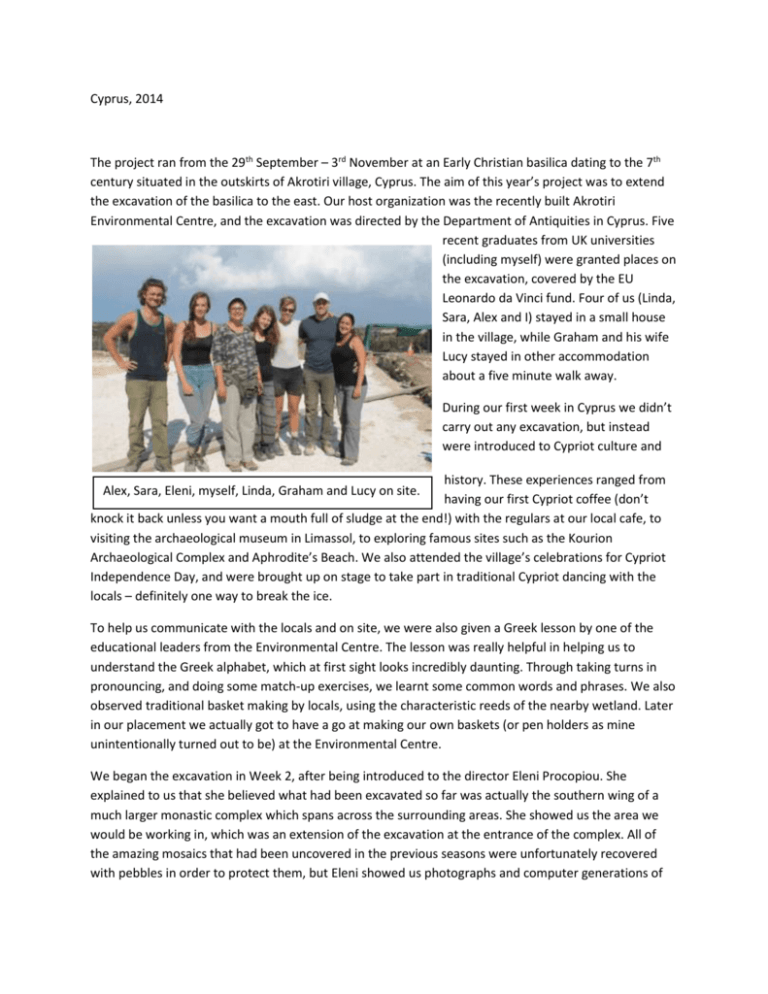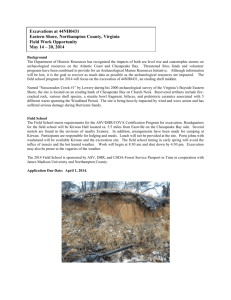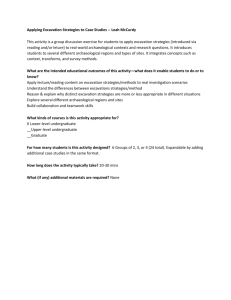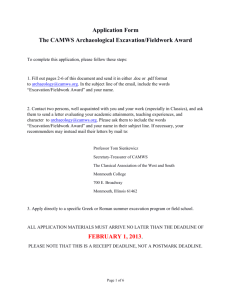Susie Dalton Cyprus 2014 Report
advertisement

Cyprus, 2014 The project ran from the 29th September – 3rd November at an Early Christian basilica dating to the 7th century situated in the outskirts of Akrotiri village, Cyprus. The aim of this year’s project was to extend the excavation of the basilica to the east. Our host organization was the recently built Akrotiri Environmental Centre, and the excavation was directed by the Department of Antiquities in Cyprus. Five recent graduates from UK universities (including myself) were granted places on the excavation, covered by the EU Leonardo da Vinci fund. Four of us (Linda, Sara, Alex and I) stayed in a small house in the village, while Graham and his wife Lucy stayed in other accommodation about a five minute walk away. During our first week in Cyprus we didn’t carry out any excavation, but instead were introduced to Cypriot culture and history. These experiences ranged from having our first Cypriot coffee (don’t knock it back unless you want a mouth full of sludge at the end!) with the regulars at our local cafe, to visiting the archaeological museum in Limassol, to exploring famous sites such as the Kourion Archaeological Complex and Aphrodite’s Beach. We also attended the village’s celebrations for Cypriot Independence Day, and were brought up on stage to take part in traditional Cypriot dancing with the locals – definitely one way to break the ice. Alex, Sara, Eleni, myself, Linda, Graham and Lucy on site. To help us communicate with the locals and on site, we were also given a Greek lesson by one of the educational leaders from the Environmental Centre. The lesson was really helpful in helping us to understand the Greek alphabet, which at first sight looks incredibly daunting. Through taking turns in pronouncing, and doing some match-up exercises, we learnt some common words and phrases. We also observed traditional basket making by locals, using the characteristic reeds of the nearby wetland. Later in our placement we actually got to have a go at making our own baskets (or pen holders as mine unintentionally turned out to be) at the Environmental Centre. We began the excavation in Week 2, after being introduced to the director Eleni Procopiou. She explained to us that she believed what had been excavated so far was actually the southern wing of a much larger monastic complex which spans across the surrounding areas. She showed us the area we would be working in, which was an extension of the excavation at the entrance of the complex. All of the amazing mosaics that had been uncovered in the previous seasons were unfortunately recovered with pebbles in order to protect them, but Eleni showed us photographs and computer generations of what they looked like. She gave us a brief history of the site in the context of other Early Christian structures in Cyprus and nearby countries, before we got started on the excavation. We split into two teams, and excavation started by takings levels and removing the surface layer of the 5 x 5m trench each team had been assigned to. This meant removing a lot of vegetation, stone and bizarre looking bugs, as well as coming across some of our first finds – beautiful carved marble pieces, the base of a glass vessel, and handfuls of wall tesserae. As we moved down into Layer One, the finds started coming thick and fast. Both teams were filling up finds boxes of beautiful relief marble carving, glass, ceramic and tesserae, as well as countless buckets of tile and unmarked marble, which the finds washing assistants were stacking up to form a mini basilica nearby. Our understanding and identification of the many marble architectural pieces we were finding was helped a lot by the architecture lesson Eleni gave in Week 3. She showed us various pictures, plans and interpretations of various similar sites in Cyprus, Greece and Turkey, and pointed out the architectural pieces that we were frequently finding on site. This helped to visualize and understand what the structure may have looked like, and how it may have collapsed. It also made finds cataloguing a lot easier, and this was a pivotal part of the excavation process in Akrotiri. We had to record Planning and drawing sections on site dimensions of every piece that we found, with photographs and drawings being required for any piece of note. The amount of material we were finding made this a big job, but Eleni and her co-director, Doria, were very helpful in their assistance. As work went on and we reached mosaic level, it became clear that the areas we were excavating didn’t hold whole mosaic floors as had been seen on other sites. We were working with some PhD students who specialised in mosaics and their conservation, and they told us it looked as if the mosaics had been destroyed before the building collapsed, perhaps suggesting the room was used as a workshop for raw materials – but that they needed to do more investigation first. While we stuck to our own trenches when it was work time, we got on well with everyone else on site. There were around 10 other Cypriot archaeologists, and two lovely women who collected our tile and marble and washed our finds. As well as this, we worked with Operation Nightingale – an initiative to place injured service personnel into archaeological fieldwork in order to gain skills, socialize and work in a team. While the majority of the Operation Nightingale participants Our trenches, Week 5. arrived just after we left, we worked with two – Les and Michelle – who had excavated at the site the previous year. Their knowledge of the site was incredibly useful, and they contributed a lot of laughter and storytelling to the site. We missed them when they left at the start of Week 4, but were kept busy by working to make sure we finished our trenches in our last two weeks of excavation. We excavated our trenches down to mosaic level, and then drew sections and plans of the trenches for the site’s records. Our penultimate day on site was marked by Eleni ordering the whole team Cypriot pita gyros (halloumi for the veggies), allowing us all to wind down and chat over the food. We finished up our work early on the last day, and spent the rest of our time taking photographs and saying goodbye to the others on the team. Some of the thousands of tesserae we found in excavation. Our excavation schedule was pretty kind – we worked from 7am – 2:30pm Monday-Friday, meaning that we had afternoons and weekends entirely free. Some weekday afternoons were spent in incredible locations. We were given a tour around the archaeological sites of the nearby RAF base, seeing some incredible, untouched sites including the late Roman port of Dreamer’s Bay. Another weekday afternoon was spent with Eleni visiting a 15th century church with incredible original frescoes all over the walls. Apart from these amazing tours, our weekday afternoons would often be spent on the beach, going for runs or going to one of the local bars (mainly to use their wifi). It was on our weekends that we went further afield. We managed to fit in a hike nearly every weekend, travelling up to the Troodos mountains and to the Atamas Peninsula for some absolutely breathtaking scenery. We also spent time in Paphos, seeing its extensive archaeological site and the Tomb of Kings, as well as heading to the capital Nicosia to catch some of the parades celebrating their resistance during WWII. The country is breathtakingly beautiful, and its size means that you can see it easily by car. Crossing over into the Turkish side is also straightforward, meaning seeing the archaeological sites over the border can easily become part of a day trip too. We were all very sad to leave Cyprus after having had such a great time there, and being part of such an interesting and exciting excavation. It was a wonderful opportunity, and made even more valuable by how friendly the locals and the excavation team were, and how they welcomed us into their culture. I would like to thank both our host organisation and Beautiful scenery on a hike in Caledonia Falls, Troodos Mountains. sending organisation for making our trip so enjoyable and educational, and would thoroughly recommend for any archaeology graduates to get involved with the GrEASE projects. - Susie Dalton







